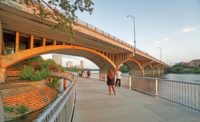SR 99 Aurora Avenue Bridge Emergency Bridge Repair
Seattle
Best Project
Owner/Lead Design Firm/Structural Engineer: Washington State Dept. of Transportation
General Contractor: Guy F. Atkinson Construction, a Subsidiary of Clark Construction
Subcontractors: Apex Steel; Purcell Painting and Coatings
Working around the clock, the project team needed just five days to repair a damaged section of an outside support beam on the busy, 80-year-old cantilever and truss bridge. The damaged beam had caused the bridge’s far right southbound lane to drop by half an inch, resulting in six lanes of traffic being temporarily funneled down to two.
The expedited repair effort was anything but easy, however, as the damaged stringer was located in the midspan of the 3,000-ft-long bridge and approximately 275 ft above the Lake Washington Ship Canal. Rather than build access scaffolding from the end of the bridge, a process that would have taken several days, the project team saved time by erecting the scaffolding system from the top of the bridge, over the side, then down to the repair site, taking care to dismantle and preserve the bridge’s decorative fencing for reinstallation once the job was complete.
Securing a temporary beam to the damaged stringer with high-strength rods alleviated pressure from the weight of the deck section above. After extracting rivets from the affected area, workers removed the damaged section and bolted a specially fabricated steel replacement section onto the existing stringer. The entire repair process was completed five days earlier than planned and significantly below the emergency contract budget.
Although restoring the bridge to full traffic capacity was a priority, speed didn’t compromise safety. To eliminate hazards from start to finish, the project team developed a detailed schedule that captured the planned work at a granular level. This hour-by-hour view kept all team members aligned and aware of what was being done at all times. The likely presence of lead-based paint on the damaged beam ensured that abatement protocols were part of the planning process. No accidents or injuries were recorded during the brief, yet highly intense repair effort.






